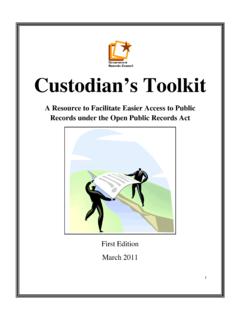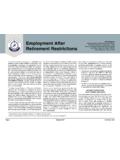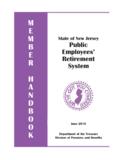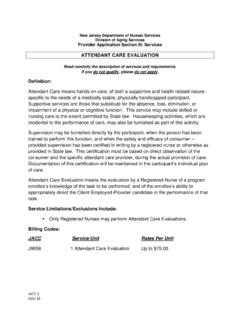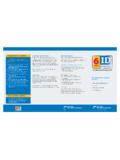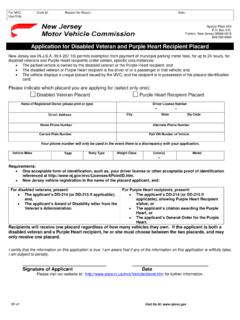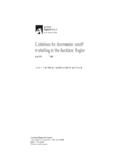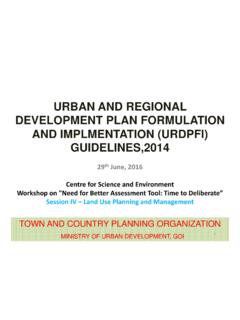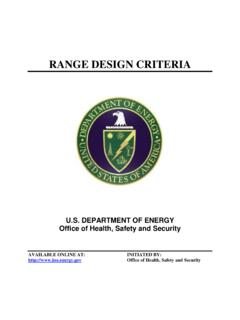Transcription of Design Manual Roadway Section 5 - Government of New …
1 BDC07MR-04 NJDOT Design Manual - Roadway 5-1 Major Cross Section Elements Section 5 Major Cross Section Elements General The major cross Section elements considered in the Design of streets and highways include the pavement surface type, cross slope, lane widths, shoulders, roadside or border, curbs, sidewalks, driveways, and medians. Due consideration should be given to the motoring and non-motoring users in designing the cross Section . Pavement Surface Type Pavement surface type is determined by soil conditions, traffic volume, traffic composition, material availability, initial cost, and the extent and cost of maintenance. All of these affect the relationship of cost to traffic service.
2 Generally, all roadways in the State are surfaced with bituminous materials or Portland cement concrete. These pavements provide good riding qualities, help to maintain the cross Section , and adequately support the expected volume and weights of vehicles without failure due to fatigue. In considering cyclists and pedestrian traffic, other Roadway surfaces include textured and colored asphalt, textured and colored concrete, and brick and other unit pavers. As part of urban Design , landscape or streetscape treatments, these are used in crosswalks, bike lanes, shoulders, and traffic calming devices. Important characteristics in relation to geometric Design are the ability of a surface to sustain its shape and dimensions, the ability to drain, and the affect on driver, bicyclist, and pedestrian behavior.
3 Cross Slope The cross slope of the pavement is the slope of the pavement surface measured transverse to the centerline of the highway. The high point of a normal cross slope of a Roadway is known as the crown. Undivided pavements on tangents or on flat curves have a high point (crown) in the middle of the traveled way and slope downward toward both edges. The minimum cross slope for concrete pavement and bituminous pavement should be percent. The cross slope shall be uniform across the pavement Section , from the high point to the edge of lane. The cross slope in each successive lane should be increased by percent. However, it may be increased on each successive pair of lanes by to 1 percent in order to cause the least disturbance to the existing border area, to limit the amount of resurfacing weight on a structure, or to minimize the cross slope in the outer lane when more than three lanes are sloped in the same direction.
4 In addition, if the cross slope of the left-turn lane is in the same direction as the adjacent lane, the adjacent lane cross slope may be used. On a divided highway, each one-way pavement may be crowned separately, as on a two-lane highway, or it may have a unidirectional slope across the entire width of pavement, which is almost always downward to the outer edge. A cross Section where each Roadway has a separate high point (crown) has an advantage of rapidly draining the pavement as shown in the top two drawings of Figure 5-A. In addition, the difference between high and low points in the cross Section is kept to a minimum. The disadvantage is, additional drainage inlets and subsurface drainage BDC07MR-04 NJDOT Design Manual - Roadway 5-2 Major Cross Section Elements lines are required.
5 In addition, treatments of at-grade intersections are more difficult because of the creation of several high and low points on the cross Section . Preferably, use of such sections should be limited to regions of high rainfall. A cross Section having no curbing and a wide depressed median are particularly well suited for high rainfall conditions. Roadways that slope only in one direction provide more comfort to drivers because vehicles tend to be pulled in the same direction when changing lanes (As shown in the bottom four drawings of Figure 5-A). Roadways with a unidirectional slope may drain away from or toward the median. Providing drainage away from the median may affect a savings in drainage structures and simplify treatment of intersecting streets.
6 Advantages of drainage toward the median are: 1. An economical drainage system, in that all surface runoff is collected into a single conduit. 2. Outer lanes, used by most traffic, are freer of surface water. A major disadvantage of drainage toward the median is all the pavement drainage must pass over the inner, higher speed lanes. Where curbed medians exist, the drainage is concentrated next to and on higher speed lanes. This concentration of drainage, when the median is narrow, results in annoying and undesirable splashing onto the windshields of opposing traffic. The rate of cross slope on curves as well as on tangent alignment is an important element in cross Section Design . See Section 4, Basic Geometric Design Elements, for speed-curvature relationships to determine pavement superelevation on curves.
7 BDC07MR-04 NJDOT Design Manual - Roadway 5-3 Major Cross Section Elements BDC07MR-04 NJDOT Design Manual - Roadway 5-4 Major Cross Section Elements Lane Widths Lane widths have a great influence on driving safety and comfort. The predominant lane width on freeways and land service highways is 12 feet. While lane widths of 12 feet are desirable on land service highways, circumstances may necessitate the use of lanes less than 12 feet. Lane widths of 11 feet in urban areas are acceptable. Existing lane widths of 10 feet have been provided in certain locations where right of way and existing development became stringent controls and where truck volumes were limited. However, new or reconstructed 10 foot wide lanes would not be proposed today, except in traffic calming areas.
8 On land service highways, where it is not practical to provide a shoulder adjacent to the outside lane, the outside lane width shall be 15 feet to accommodate bicyclists. Where alternate bike access is provided, the outside lane width should be 1 foot wider than the adjacent through lane width. The designer should strive to accommodate the bicyclist and pedestrian on all projects. When resurfacing existing highways that have lane widths of 10 feet or less, the existing lanes should be widened to either 11 foot minimum or 12 foot desirable. Auxiliary lanes at intersections are often provided to facilitate traffic movements. Such lanes should be equal in width to the through lanes but not less than 10 foot wide when constructed adjacent to a shoulder.
9 When there is no right shoulder adjacent to a new or reconstructed auxiliary lane, the width of the auxiliary lane shall be designed to accommodate the bicyclist. Where alternate bike access is provided, the auxiliary lane width should be 1 foot wider than the adjacent through lane width. The criteria in this paragraph shall also apply to auxiliary lanes at interchanges on land service highways. On Interstates and freeways, the width of the auxiliary lane shall be 12 feet. Lane widths for specific types of highways are enumerated as part of the typical sections illustrated at the end of this Section . For the width of climbing lanes and left-turn lanes, see Section 4, Basic Geometric Design Elements and Section 6, At-Grade Intersections, respectively.
10 Shoulders General A shoulder is the portion of the Roadway contiguous with the traveled way for accommodation of stopped vehicles, for emergency use, and for lateral support of subbase, base and surface courses. Some of the more important advantages of providing shoulders are: 1. Space for the motorist to pull completely off the Roadway for emergencies. 2. An escape zone to allow motorists to avoid potential accidents or reduce accident severity. 3. An aid to driver comforts by creating a sense of openness; improves highway capacity. 4. An improvement in sight distance in cut sections. 5. A provision to enhance lateral clearance for the placement of signs, guide rails, or other roadside appurtenances.
